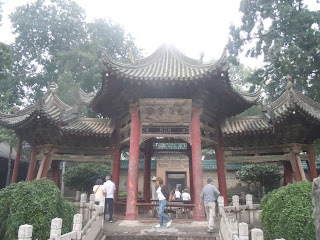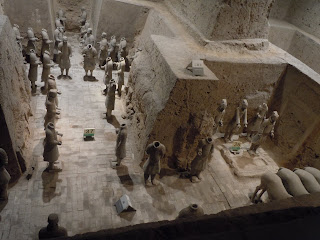This posting will cover a bit of time, since I haven’t posted in a while, partly because we’ve been rather busy traveling to, exploring, and getting settled in Xian and partly because my VPN hasn’t been working since I’ve arrived in Xian, so I’m having difficulty accessing my own blog. I had wondered if this would be a problem when I was still in the States, but wasn’t sure how I could check it then…
Quick overview of the first week in China:
Beijing was a lot of fun, definitely a good place to start our exposure to
China. Tiananmen Square
(天安门广场), the Forbidden City
(故宫)and the (New) Summer Palace
(颐和园)were all worth seeing. We unfortunately didn’t have enough time to visit any of the Great Wall while in
Beijing, but the three aforementioned historical places were a good start. Even though these areas were filled with lots of tourists, it never seemed that crowded (except for in certain bottleneck areas) because they’re all so large and wide. Tiananmen Square seems almost like a mile long (I’m sure it’s not, but it seemed ridiculously long); the
Forbidden City likewise was much grander and larger than I ever would’ve suspected. We only walked around a fraction of the
Summer Palace, and even that seemed rather long.
Beijing definitely has a lot left to be explored and enjoyed, so hopefully our counterparts studying there will take advantage of that.

Tiananmen Square (looking SW)

Tiananmen (Gate of Heavenly Peace)

Walking through the Forbidden City

Looking Southward at the Forbidden City

View in the Summer Palace

View in Summer Palace of a replica of Southern Chinese architecture
We left
Beijing by taking a thirteen hour train ride to Xian. (Side note: thirteen is popping up everywhere with travel. Thirteen hour plane ride, thirteen hour time-zone difference [I live in Central Standard Time], thirteen hour train ride, and there are thirteen of us students here in Xian…) Trains are a lot more squished in China. We did all get beds, which was nice, but because of that, it was rather difficult to just sit around and hang out. The train also left around 5:00 pm, so a lot of the train ride was in the dark, which was slightly disappointing because I wanted to see some more of countryside. We arrived in Xian around 7:00am and got a quick tour of the downtown area as we were taxied to our new home,
Shaanxi Normal University.
The city of Xian is a lot of fun even to just wander the streets. It’s a lot of fun people watching and seeing the large variety of people in this bustling city: from construction workers to Muslim restaurant owners to fashionable hair dressers to the high school students in matching uniforms to all of the little children who sometimes have a tendency to stare at us. Speaking of children, some observations: little children are allowed, and often do, to go to the bathroom right on the streets. To aid in this, they sell slit pants (开裆裤). Think of chaps, but then the child doesn’t wear any pants or diaper underneath. Also, a lot of children have extremely short hair, sometimes completely shaven, though I’ve seen a lot of interesting hair styles on children. For instance, one little boy I saw at the mall arcade had a shaven head except for a heart on the top (the point of the heart was on his forehead) and a star on the back, right above his neck.
Our first “touristy” thing in Xian was to visit the Big Wild Goose Pagoda (
大雁塔). This pagoda was erected to house Buddhist scriptures brought over from India and aid in translating the scriptures into Chinese. The pagoda grounds still house various Buddhist statues and a few monks could be seen walking around. Despite really wanting to climb the pagoda, I someone missed the opening and instead spent the hour wandering the grounds. I was able to appreciate a lot of the gardens and architecture, not to mention the Buddhist statues, but almost everyone else made the climb. They said I didn’t miss much, so I’ll just have to take their word for it. We also had a mini scavenger hunt with some of the Chinese roommates in the square outside the pagoda. That was a lot of fun, even if our team barely came in second place.

View of the Pagoda from the northern garden temple area
The “dorm” we’re staying in is actually a hotel. They really seem to want to provide nice accommodations for their international students, because they don’t think we could adjust to normal dorm conditions or have had too many incidents and want to avoid them now, I don’t know. I’m figuring more of the first, but wouldn’t be surprised if the latter has happened. The nice thing about our “hotel dorm” is that we do have maids come in and empty our trash and replace towels and toiletries (including the ever elusive toilet paper!) every day. The downside is a communal kitchen and washing machines for the entire building, so making our own food and cleaning clothes might be a challenge. There also isn’t a ton of room in the room, especially once there are two of us living in it. Our Chinese roommates are living in their normal dorms for this first week to help us adjust more smoothly. (If what I’ve gathered is correct, in China, college students are assigned three roommates and a dorm room that they keep all four years.)

Our "dorm" room. A bit of an upgrade...
We started Chinese language classes on Tuesday. They are intense, but that should only help us out in the long run (or even the “short term” of being in China). There are five of us in my Chinese class, which allows us to ask questions and practice speaking a lot more than the 15 – 20 student classes I was used to at U of I. We do, however, have way more homework here than at U of I, and have three hours of Chinese every day.
Today (Thursday) we had a “debate” in Chinese about whether or not women should have to stay home to look after the house and children or if they should be allowed to be career women. It was interesting and I don’t think 75% of what we were trying to say made any sense, but I suppose it’s a good testament to our improvement in Chinese, even if it was a rather rudimentary “debate”. I am becoming more comfortable using Chinese on a regular basis, though, and am not horribly stumbling when I’m in a restaurant any more, for the most part.
We still have to point a lot to the foods we want, as we have yet to order anything that we know all of the character for; unfortunately, we keep forgetting to write down what we ordered to look it up later or to remember it to order the same dish again. Luckily food is very cheap and we’ve yet to order anything we didn’t enjoy, though we might’ve been too hungry to have cared.
One of our first nights in Xian, we ended up going to a seafood restaurant. At this restaurant, you basically order a fish (which you then go pick out in the tank) and then select how you want it prepared and any additional sides to eat. However, since we all are extremely limited in our Chinese, we didn’t realize this and at first only ordered the sides, thinking they were normal plates of food. (They had pictures, so we had some semblance of what we were getting.) We wondered why the waitress looked at us strangely after we ordered, and eventually understood that we probably should’ve ordered some fish, since it was a seafood restaurant. So we said (or at least tried to say) that we wanted a fish, but then the waitress tried to explain to us (in very quick and complicated Chinese) that we needed to select a category of fish, a method of preparation and then follow her to pick one out. It was a good 5 or 10 minutes of frustration and laughter at our limited Chinese before we understood enough to finish the order. As one of the girls said, “If only she had said ‘看 and 鱼’(look and fish)” maybe we could’ve saved ourselves a lot of embarrassment. It all ended fine, and the fish was delicious. And it made for a good story.



























